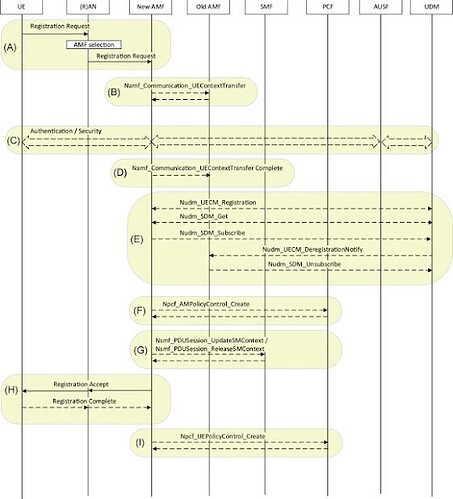Let’s have a look on 5G call flow of registration procedure .
Note: Image used here are taken from SourceDirect.com for fair use.No Copyright infringement intended.
As you can see in the above image that UE has to register itself before using the 5G services . The registration are of several types which are listed down below:
- Initial Procedure Registration
- Periodic Procedure Registration
- Mobility Procedure Registration
- Emergency Procedure Registration
In Initial Procedure, when UE is Power-On and ready for registration .Periodic procedure is to keep watch of UE status , if it become inactive , due to some reasons like battery discharge .Mobility procedure is when UE move to another location and then it have to register it, under this procedure.Emergency procedure is when there is any emergency like situations ,then this procedure is used.
Now lets a deep dive how a UE Register itself to a 5g network for using its services.
- For a registration from UE , it send a registration request to RAN(gNB). Now RAN sends this request to the AMF(Access and Mobility Function).Now how RAN know which AMF it would transfer this request.
So, there are two scenarios : first , if UE has any registration before , it has assigned a identifier , GUTI(Globally Unique Temporary Identifier) ,through which RAN can know the correct AMF which serve this UE before .
Second, if this is the first time of UE registration with the network then, through NSSAI(Network Slice Selection Assistance Information) Slice identifier , RAN search and found which AMF can serve this type of slice and connect to it and sends this request to that appropriate AMF.
-
Now consider the case if UE move to another location then , how things will work. So in this case the UE trying to update its registration and connect to the new AMF , so as it is a mobility triggered process , there is already UE context with the old AMF so this UE context will transfer from old Amf to the new one , and now UE communicate to the new AMF .
-
Now AMF authenticate and authorised UE through, communicate to UDM(Unified Data Management) .
-
As the new AMF has taken the charge of UE , so new AMF will register itself to the UDM and tell it , now I am serving the UE , so that is can take the subscriptions and other updates from UDM regarding the UE. As old AMF has nothing to do with this UE has it is being serve by other one , So UDM notify old AMF to deregister itself regarding this UE and PCF(Policy and Control Function) will no longer serve to this old AMF as its no required policy regarding this UE.
-
The new AMF fetch the policy regarding the access and mobility functions from the PCF for UE to serve . If there is any PDU(Protocol Data unit Session) regarding this UE then, new AMF will communicate to SMF (Session and Management function) to continue the session , if there’s any mismatch in it , the PDU Session terminate using session release management and new PDU session will created according to the need of UE wants.
6.When AMF authenticate UE from UDM then, it sends a message of registration acceptance and UE also sends a acknowledgement of registration acceptance to the AMF for it to know that registration acceptance message has send to the intended UE.
